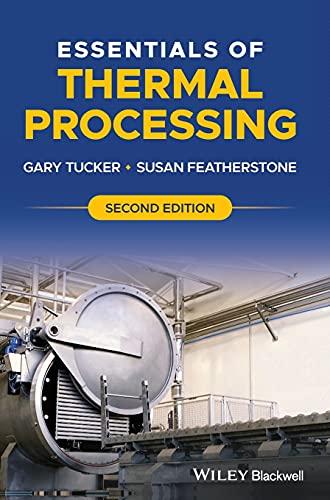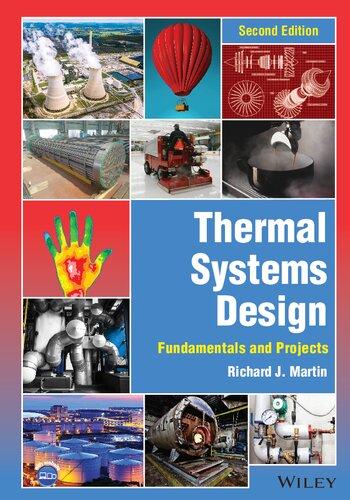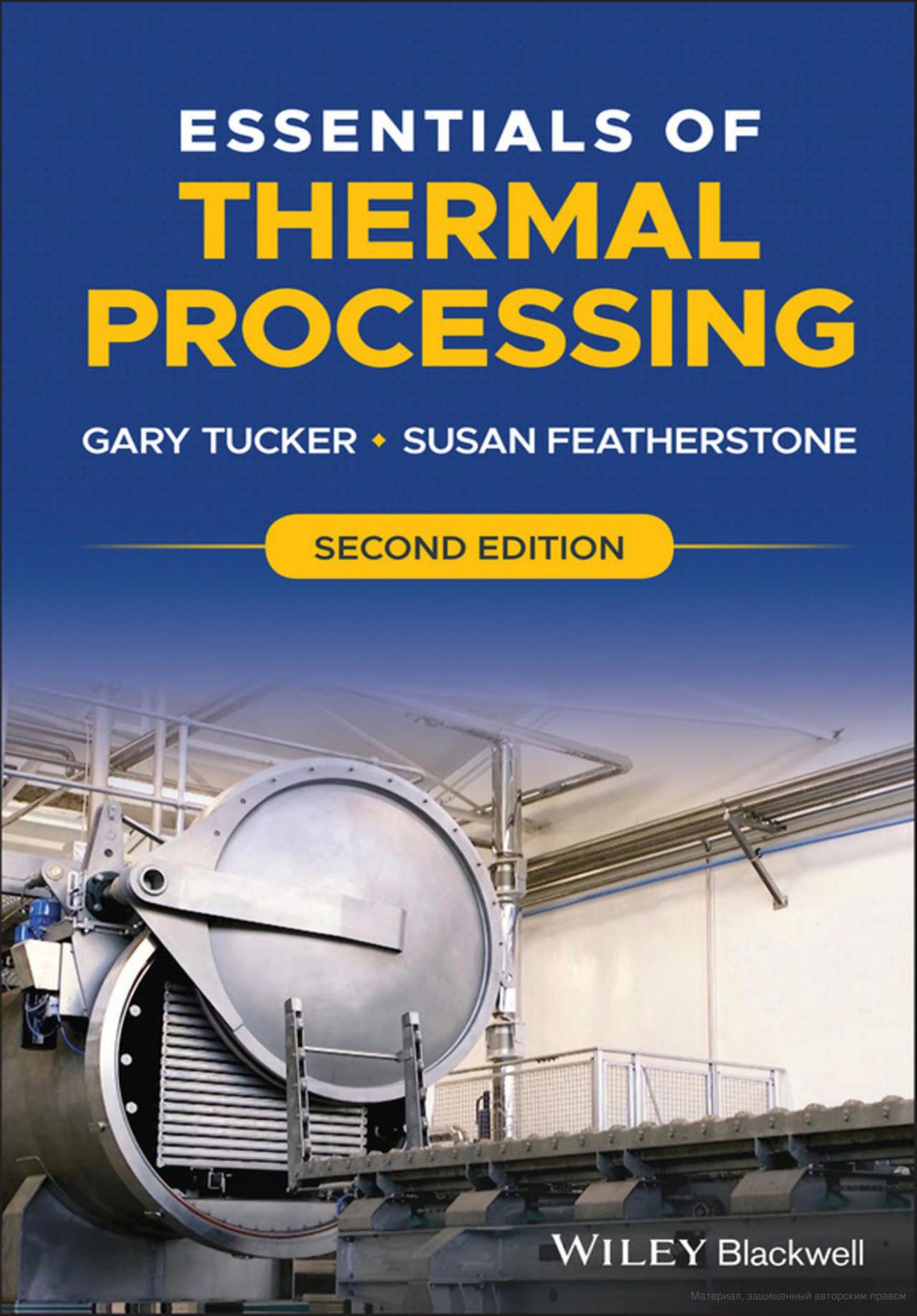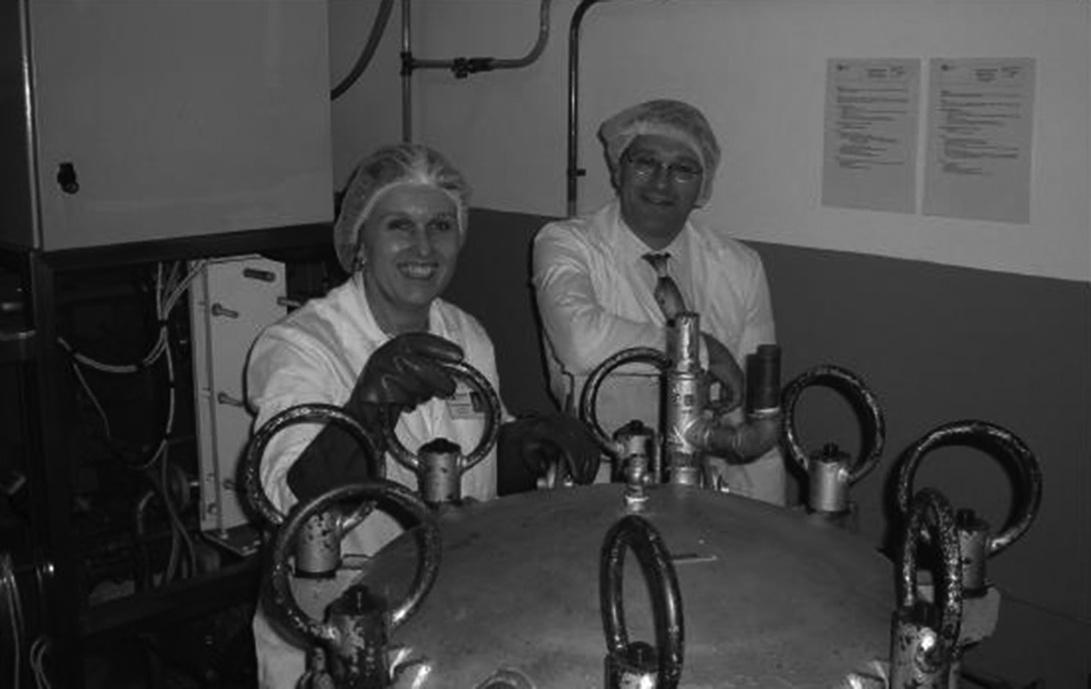Essentials of Thermal Processing
Second Edition
Gary Tucker
Campden BRI, Gloucestershire, UK
Susan Featherstone
Safe Food Consulting, Cape Town, South Africa
This second edition first published 2021 © 2021 John Wiley & Sons Ltd
Edition History
Wiley-Blackwell (1e, 2010)
All rights reserved. No part of this publication may be reproduced, stored in a retrieval system, or transmitted, in any form or by any means, electronic, mechanical, photocopying, recording, or otherwise, except as permitted by law. Advice on how to obtain permission to reuse material from this title is available at http://www.wiley.com/go/permissions.
The right of Gary Tucker and Susan Featherstone to be identified as the author(s) of this work has been asserted in accordance with law.
Registered Office(s)
John Wiley & Sons, Inc., 111 River Street, Hoboken, NJ 07030, USA
John Wiley & Sons Ltd, The Atrium, Southern Gate, Chichester, West Sussex, PO19 8SQ, UK
Editorial Office
The Atrium, Southern Gate, Chichester, West Sussex, PO19 8SQ, UK
For details of our global editorial offices, customer services, and more information about Wiley products, visit us at www.wiley.com.
Wiley also publishes its books in a variety of electronic formats and by print-on-demand. Some content that appears in standard print versions of this book may not be available in other formats.
Limit of Liability/Disclaimer of Warranty
The contents of this work are intended to further general scientific research, understanding, and discussion only and are not intended and should not be relied upon as recommending or promoting scientific method, diagnosis, or treatment by physicians for any particular patient. In view of ongoing research, equipment modifications, changes in governmental regulations, and the constant flow of information relating to the use of medicines, equipment, and devices, the reader is urged to review and evaluate the information provided in the package insert or instructions for each medicine, equipment, or device for, among other things, any changes in the instructions or indication of usage and for added warnings and precautions. While the publisher and authors have used their best efforts in preparing this work, they make no representations or warranties with respect to the accuracy or completeness of the contents of this work and specifically disclaim all warranties, including without limitation any implied warranties of merchantability or fitness for a particular purpose. No warranty may be created or extended by sales representatives, written sales materials, or promotional statements for this work. The fact that an organization, website, or product is referred to in this work as a citation and/or potential source of further information does not mean that the publisher and authors endorse the information or services the organization, website, or product may provide or recommendations it may make. This work is sold with the understanding that the publisher is not engaged in rendering professional services. The advice and strategies contained herein may not be suitable for your situation. You should consult with a specialist where appropriate. Further, readers should be aware that websites listed in this work may have changed or disappeared between when this work was written and when it is read. Neither the publisher nor authors shall be liable for any loss of profit or any other commercial damages, including but not limited to special, incidental, consequential, or other damages.
Library of Congress Cataloging-in-Publication Data
Names: Tucker, Gary, author. | Featherstone, Susan, author.
Title: Essentials of thermal processing / Gary Tucker, Campden BRI, Gloucestershire, UK, Susan Featherstone, Safe Food Consulting Cape Town, South Africa.
Description: Second edition. | Hoboken, NJ : Wiley-Blackwell, [2021] | Includes bibliographical references and index.
Identifiers: LCCN 2020056297 (print) | LCCN 2020056298 (ebook) | ISBN 9781119470373 (cloth) | ISBN 9781119470359 (adobe pdf) | ISBN 9781119470328 (epub)
Subjects: LCSH: Food–Effect of heat on. | Food–Preservation. | Food–Microbiology.
Classification: LCC TP371 .T83 2021 (print) | LCC TP371 (ebook) | DDC 664/.028–dc23
LC record available at https://lccn.loc.gov/2020056297
LC ebook record available at https://lccn.loc.gov/2020056298
Cover Design: Wiley
Cover Image: © H G Molenaar & Co. (Pty) Ltd
Set in 11/13pt Times by SPi Global, Pondicherry, India
10 9 8 7 6 5 4 3 2 1
5 Acid Foods and Other Pasteurised Products
6.5.1
6.5.2
6.5.3
6.6
6.7
7.1
6.7.1
6.7.2
6.7.3
6.7.4
6.7.5
7.1.1.2
7.1.2
7.2
8.1
7.2.1
8.2
8.1.2
8.1.3
8.1.4
8.1.5
8.1.6
8.1.7
8.1.8
8.2.1
8.2.2
7.2.1.1
9
10
11
14.2.8
14.3.5.2
14.4.3.3
15.4.2.1
16 Critical Factors in Thermal Processing
17
Preface
Essentials of Thermal Processing is written by two authors with many years’ experience of thermal processing practice, one gained in the northern hemisphere and one in the southern hemisphere. This gives the book a unique appeal. It covers all aspects of thermal processing from its beginnings in 1795 with Nicolas Appert through to modern day computer-controlled processing systems and electronic data capture. The intention was to write a book of practical use to students studying food science and technology as well as for their lecturers, individuals in companies, and research centres that have a need to understand thermal processing principles.
In this second edition, we have tried to expand on the information given so that this book is the one stop, single text required to assist with all thermal processing queries. The second edition starts with the history of thermal processing, from the prize-winning invention in the Napoleonic era, and describes many of the developments that resulted in the precise science that we know today. The next chapter covers basic microbiological principles that govern microbial growth and death. Detail about microorganisms of particular interest to thermal processing specialists is given as well as information about solving spoilage problems. The third chapter is dedicated to the hurdles to the growth of microorganisms so that the reader gains a thorough understanding of how to ensure a safe product.
The next chapters take the reader through the different food categories that present their unique challenges for thermal processing. This includes the traditional sector of low acid foods in which the familiar F03 concept was derived from heat resistance studies originally undertaken by Esty and Meyer in 1922. Low acid foods are a group of foods that do not contain any preservation hurdles to microorganism growth and rely on the heat process to control microorganism numbers in the food and a hermetically sealed package to prevent recontamination. Chapters 5 and 6 are
on acid and acidified foods. The chapters are separated to describe the different principles and the types of thermal processes that are applied. In the acid foods chapter, information is included about other products that can be pasteurized. The last of the chapters that deals with a specific food group is on heat preserved chilled foods, which is one of the most rapidly growing sectors in Europe. This includes the ready meal concept and ready-to-eat meat, fish, and poultry products. Shelf-life requires refrigerated storage and is typically up to 10 days when a very mild process is used or it can be extended beyond this with more severe thermal treatments.
Chapter 8 describes processing methods that can be used for manufacturing heat preserved foods. It is divided into in-pack or in-line systems, often known as retorts and continuous systems. The focus of this chapter is the operating principles of the different designs. The main types of retort are described, for example steam, steam-air, water immersion, raining, and sprayed water, also included are the in-pack continuous retorts such as hydrostatic and reel and spiral cooker–cooler systems. Equipment choice for a continuous or in-line system depends mostly on the food viscosity and whether the flow behaviour is laminar or turbulent.
Thermal processing of foods has a dual purpose, which is to commercially sterilize the product and to cook it to an acceptable level. The chapter on cooking and process optimization addresses the challenges of maximizing a specific quality attribute without damaging the thermal processing effect on microbial reduction. Examples are given on the different quality parameters appropriate to heat preserved foods and how these can be mathematically analysed with the aim of adjusting processes so that maximum quantities of a nutrient, such as a vitamin, are retained.
Techniques for establishing and validating thermal processes are described in two chapters. Temperature and heat transfer are explained and process calculation methods are discussed. Measurement techniques for in-pack processes include temperature sensors of various types and log reduction methods that can be either microbiological or biochemical. Process calculation techniques are introduced, which allow process conditions to be calculated from the temperature measurements and analysis of deviations to be carried out. Differences in the techniques required for batch (in-pack) and continuous (in-flow) heat processes are described.
Chapter 12 discusses cooling water; almost all types of microorganisms can be found in water, and water is most often the vehicle of transmission for these organisms. Poor quality cooling water or inadequate cooling is arguably the most significant causes of public health issues from canned foods in the last century. Examples of spoilage incidents caused by cooling issues are dealt with in several chapters, and so, this chapter solely describes the different methods of disinfecting cooling water.
Despite the best efforts to control all aspects of a thermal processing operation, all factories will experience process deviations from time to time. Chapter 13 is dedicated to process deviations and describes methods to assess whether a process deviation has made a critical impact on the commercial sterility or safety of a product. Methods to assess a deviation are many and include calculation methods as well as experimentally recreating the deviation using retort simulators.
Packaging of the product also demanded its own chapter. Understanding packaging options and the way they work together with the product is critical to the success of any food packaging system. The functions of packaging are to contain, protect, preserve, portion, inform, promote, and make foods portable. Packaging options for thermally processed foods are many and include metal (mainly tinplate, but some aluminium), glass, cartons, and specific plastics (laminates and composites). Primary packaging must be able to hold a hermetic seal, withstand the process temperature, provide a physical barrier, withstand the physical stresses during processing, transport, storage, and distribution, and must not react adversely with the food.
Incubation of processed packs is commonplace in the food industry; however, a variety of incubation practices occurs, which suggests that there is no standardized approach. Chapter 15 describes the objectives of incubation together with some recommendations for times and temperatures that different types of microorganism require. It includes suggestions for sample size and methods for interpretation of results.
The penultimate chapter is about the critical control factors (CCP’s) involved in thermal processing of food. HACCP (Hazard Analysis Critical Control Point) is a tool to assess hazards and establish control systems that focus on prevention rather than relying mainly on end-product testing. Examples are given of CCPs of relevance to thermal processing.
The final chapter presents a different focus for thermal processing in that it deals with environmental aspects and presents a positive case for thermal processing. As a technology for preserving food, it can be environmentally beneficial because the goods are stored ambient, thus avoiding the need for refrigeration, and allows agricultural products to be processed close to where they are grown, thus avoiding transportation emissions and forcing crops to grow out of season. An example of a carbon footprint assessment is given in this chapter for a bottled apple juice.
Gary Tucker
Susan Featherstone
Preface xix
The authors during a practical training course session in Cape Town.
Glossary of Terms
Acid
Acid Foods
Acidified Low-Acid Food
Acidified Food
A substance which increases the concentration of hydrogen ions (H+) in water, and reacts with a base to form a salt.
A food that has a natural pH of 4.6 or below (in Europe it is common to use pH 4.5 as the upper limit).
A food which has been treated so as to attain an equilibrium pH of 4.6 (or 4.5 in Europe) or lower after heat processing.
A low-acid food to which acid(s) or acid food(s) are added and which has a finished equilibrium pH of 4.6 or below and a water activity (aw) greater than 0.85.
Acidulant
Aciduric
Aerobes
Aerobic
An acidifying agent, such as acetic acid or vinegar.
Micro-organisms that can grow in high acid foods, i.e., with a pH value below 3.0. Generally, are of low heat resistance.
Micro-organisms that need oxygen for growth. Obligate aerobes cannot survive in the absence of oxygen.
Living or active only in the presence of free oxygen.
Anaerobes
Anaerobic
Anti-Microbial
Antioxidants
Aseptic Processing and Packaging
Asepsis
Autoclave
Bacillus
Bacillus Cereus
Micro-organisms that grow in the absence of oxygen. Obligate anaerobes cannot survive in the presence of oxygen. Facultative anaerobes normally grow in oxygen, but can also grow in its absence.
Living or active in the absence of free oxygen.
A compound which inhibits the growth of a microbe.
Substances that retard the oxidative rancidity of fats, or the oxidation of other substances.
The filling of a commercially sterile product into sterilised containers followed by hermetical sealing with a sterilised closure in an atmosphere free from micro-organisms.
Clean and free of micro-organisms.
A vessel in which high temperatures can be reached by using high steam pressure. Bacteria are destroyed more readily at elevated temperatures, and autoclaves are used to sterilize food, for example in cans.
A rod-shaped bacterium. Some Bacillus produce spores.
Spore-forming, rod-shaped bacterium, aerobic to facultative aerobic, proteolytic. It produces gastroenteritis caused by the release of an exo-enterotoxin during lysis of B. cereus in the intestinal tract.
Bactericide
Bentonite
Any substance that destroys bacteria, although not necessarily the spores of bacteria.
Colloidal clay used as an absorbent. Also used in model systems for determining rate of heat penetration.
Biodegradability
Biological Oxygen Demand (BOD)
Susceptibility of a chemical compound to depolymerization by the action of biological agents.
Micro-organisms consume oxygen in their respiration. The BOD test determines uptake of oxygen by a contaminated material, e.g., sewage, water, etc., as a measure of microbial activity.
Blanching
Body Hook
Body Maker
Boiler Scale
Botulism
Break-Point Chlorination
Brines
Heating by direct contact with hot water or live steam. It softens the tissues, eliminates air from the tissues, destroys enzymes, and washes away raw flavours.
That flange portion of the can body that is turned back for the formation of the double seam.
A machine for automatic forming of a cylindrical metal can or drums body from a body blank. In the manufacture of tin cans, the body maker may also automatically weld the side seam.
Deposit left inside boilers caused by evaporation of water and precipitation of water-soluble and insoluble substances.
A poisoning caused by substances formed by the bacterium Clostridium botulinum under conditions of improper processing and storage of food. The spores of this bacterium are often found in soil and are likely to be present on soil-contaminated food.
Addition of chlorine to water beyond the point where chloramines are oxidized, and where further increases in the dosage of chlorine will result in a proportional increase of chlorine residual.
Salt solutions used in canning and pickling.
Glossary of Terms
Brix
Broken Heating Curve
The measure of density of a solution, more particularly a solution containing sucrose, as determined by a hydrometer. Degrees Brix equal Percent sucrose in water solution at 20°C.
A heating curve which shows a distinct change in the rate of heat transfer such that the curve may be represented by two or more distinct straight lines.
Broth Medium A liquid medium for growth of microorganisms.
Browning Reaction
Buffer
Canned Food
Carbohydrates
A reaction in foods, usually deteriorative, involving amino (e.g., from amino acids or proteins) and carbonyl (e.g., from glucose) groups; this reaction often leads to a brown discolouration and sometimes to off-flavours and changes in texture.
Any substance in a fluid which tends to resist the change in pH (hydrogen-ion concentration) when acid or alkali is added.
Commercially sterile food in hermetically sealed containers.
Carbohydrates are essential food nutrients that can get broken down into glucose to be used as energy. They are comprised of C, H and O. Examples include starches, sugars and fibre.
Carcinogen A cancer causing agent.
Cation
Positively charged ion such as K+, NH4+.
Cationic Surfactants
Celsius (°C)
Chemical Oxygen Demand (COD)
Ionic surface active agents in which the portion that associates with the internal phase is the cation. They include simple amine salts, quaternary ammonium salts, amino imides and imidazolines. Cationic surfactants often have germicidal, anticorrosive, and anti-static properties.
Temperature on a scale of 100° between the freezing point (0°) and the boiling point (100°) of water.
An indirect measure of the biochemical load exerted on the oxygen content of a body of water when organic wastes are introduced into the water. When the wastes contain only readily available organic bacterial food and no toxic matter, the COD values can be correlated with BOD values obtained from the same wastes.
Chlorination
Clostridia
Closure
Coccus
Building up the chlorine content (as hypochlorous acid) to process or sanitize water supplies.
Genus of spore forming bacteria. Clostridium botulinum is the most heat resistant of the food-poisoning organisms; its growth is inhibited at pH 4.6 and below, thus it is only a problem in low-acid foods. Produces an endotoxin, highly toxic in minute doses, but destroyed by heat. Destruction of this organism is generally accepted as the minimum standard of processing for low-acid and medium-acid canned food, although other Clostridia are more heat-resistant.
The joint or seal which is made in attaching the cover to the glass container. Also, the type of closure, such as friction, lug, screw top, etc.
Shape of bacteria (plural cocci). A round / spherical cell.
Codex
Codex Alimentarius (Latin for “Book of Food”) is a collection of internationally recognized standards, codes of practice, guidelines and other recommendations relating to foods, food production and food safety. The texts are developed and maintained by the Codex Alimentarius Commission, a body that established by the Food and Agriculture Organization of the United Nations (FAO), and later was joined by the World Health Organization (WHO).
Coliform Bacteria
Colony
Come-Up Time (CUT)
Commercial Sterility
Group of aerobic bacteria of which Escherichia coli is the most important member. Many coliforms are not harmful, but as they arise from faeces, they are useful as a test of contamination, particularly as a test for water pollution
A microscopically visible growth of microorganisms on a solid culture medium.
The time which elapses between the introduction of steam into the closed retort and the time when the retort reaches the required processing temperature.
The condition achieved by application of heat which renders such food free of viable forms of micro-organisms having public health significance, as well as any microorganisms of non-health significance capable of reproducing in the food under normal non-refrigerated conditions of storage and distribution. “Commercial sterility of equipment and containers used for aseptic processing and packaging of food means the condition achieved by application of heat, chemical sterilant(s), or other appropriate treatment which render such equipment and containers free of viable forms of microorganisms having public health significance, as well as any micro-organisms of nonhealth significance capable of reproducing in the food under normal non-refrigerated conditions of storage and distribution.
Consistometer
Contamination
Controlled Atmosphere (CA) Storage
Convection
Corrosion
Corrosion Accelerator
Countersink Depth
Critical Factor
One of the several types of instruments used to measure the consistency of foods.
Entry of undesirable organisms into some material or container.
Storage of foods in a hermetic warehouse where the concentrations of O2, CO2, and N2 are controlled at specific levels.
Natural or forced motion in a fluid induced by heat or the action of gravity.
Chemical action of dissolving the surface of a metal (e.g. tin in food medium).
Chemical species with the ability to accept electrons, which will increase the rate of a corrosion reaction.
The measurement from the top edge of the double seam to the end panel adjacent to the chuck wall.
Any property, characteristic, condition, aspect, or other parameter, variation of which may affect the scheduled process delivered and thus the commercial sterility of the product. This does not include factors which are controlled by the processor solely for purposes of product appearance, quality, and other reasons which are not of public health significance.
Culture
Culture Medium
A population of micro-organisms cultivated in a medium; pure culture-single kind of micro-organism, mixed culturetwo or more kinds of micro-organisms growing together.
Any substance or preparation suitable for and used for the growth and cultivation of micro-organisms.
D-value (decimal reduction time)
Deaeration
Dehydration
Detergent
Deterioration
Detinning
Disinfectant
Disinfection
Time in minutes at a specified temperature required to destroy 90% of the microorganisms in a population.
Removal of oxygen from produce juices to prevent adverse effects on juice properties.
A food processing unit operation resulting in the removal of water from the food generally to the point where spoilage is prevented.
Surface-active material or combination of surfactants designed for removal of unwanted contamination from the surface of an article.
A non-biological, physical, or chemical change in food which adversely affects quality.
The process of corrosion, where the internally plain tin coating is slowly dissolved by the food medium; rapid detinning refers to abnormally fast tin dissolution, caused by the presence of corrosion accelerators.
An agent that frees from infection by killing the vegetative cells of microorganisms.
The reduction, without adversely affecting the food, by means of hygienically satisfactory chemical agents and /or physical methods, of the number of micro-organisms to a level that will not lead to harmful contamination of food.
Double Seam
Drained Weight
Effluent
Emulsion
Endotoxin
Enterotoxin
Enzymatic Browning
Enzyme
Equilibrium pH
Glossary of Terms xxix
To attach an end to a can body by a method in which five (5) thicknesses of plate are interlocked or folded and pressed firmly together. A joint formed by interlocking the edges of both the end and body of a can.
Weight of the solid portion of the product after draining the covering liquid for a specified time with the appropriate sieve.
Waste water or other liquid, partially or completely treated or untreated, flowing out of a process operation, processing plant, or treatment plant.
System consisting of two incompletely miscible liquids, one being dispersed as finite globules in the other. A small amount of a third substance may render the dispersion stable. The liquid broken up into globules is the dispersed (discontinuous) phase; the surrounding liquid is the external (continuous) phase.
A toxin produced with an organism liberated only when the organism disintegrates.
A toxin specific for cells of the intestine. Gives rise to symptoms of food poisoning.
The darkening of plant tissues or products produced by enzymatic reactions.
A compound of biological origin which accelerates a specific chemical reaction.
The pH of the macerated (thoroughly blended) contents of the product container.
Equilibrium Relative Humidity
The relative humidity of the ambient atmosphere surrounding a substance when the substance neither gains nor loses moisture.
Escherichia Coli
Exotoxin
F-value
Facultative Bacteria
Fahrenheit
Fermentation
Fill Weight
Flash Pasteurization
The strains of E. coli that produce an entero-pathogenic food poisoning syndrome.
A toxin excreted by a micro-organism into the surrounding medium.
The number of minutes required to destroy a stated number of micro-organisms at a defined temperature, usually l21.1°C (250°F), and when the z-value is 10°C (18°F). “F” value is a common term employed in the canning industry to express the lethality or sterilizing value of a sterilization process. See also z-value.
Bacteria which can exist and reproduce under either aerobic or anaerobic conditions.
A temperature scale in which 32°F represents the freezing point of water and 212°F represents its boiling point.
The action of micro-organisms upon foods. Anaerobic respiration. Usually fermentation is undesirable, but sometimes it is produced intentionally, such as in the manufacture of vinegar from apple cider.
The weight of the product before processing. It does not include the weight of the container or covering liquid.
Process in which the material is held at a much higher temperature than in normal pasteurization, but for a considerably shorter period.
Flat sours
Flexible Container
Flipper
Food Infection
Thermophilic and thermoduric bacteria, facultative anaerobes that attack carbohydrates with the production of acids, but without gas formation. Flat-sour spoiled canned foods therefore show no swelling of the ends.
A container where the shape or contours of the filled, sealed container are affected by the enclosed product.
A can having both ends flat, but with insufficient vacuum to hold the ends in place, thus a sharp blow will cause the end to become convex, but both ends may be pressed to their normal position.
An illness caused by an infection produced by invasion, growth and damage to the tissue of the host due to the ingestion of viable pathogenic micro-organisms associated with the food.
Food Intoxication
Food Poisoning
An illness resulting from the ingestion of bacterial toxin with or without viable cells. The illness does not require actual growth of cells in the intestinal tract.
A general term applied to all stomach or intestinal disturbances due to food contaminated with certain micro-organisms or their toxins.
Fortified
Fungicide
Fungistatic Agent
Food to which specific nutrients have been added “enriched”.
Any substance that destroys fungi or inhibits the growth of spores or hyphae. Legally, sometimes the term is interpreted as also including yeasts and bacteria.
Prevents growth of fungi (moulds) without necessarily killing the existing cells.
GRAS
HACCP
Halophilic
Hard Swell
Headspace, Gross
Generally Recognized as Safe.
Hazard Analysis of Critical Control Points. An inspectional approach that determines what points in the process are critical for the safety of the product and how well the firm controls these points.
Can grow or survive in a medium with a relatively high salt concentration.
Spoilage in which can ends are swelled too hard to be readily depressed by applying thumb pressure.
The vertical distance between the level of the product (generally the liquid surface) and the inside surface of the lid in an upright rigid container (the top of the double seam of a can or the top edge of a glass jar).
Headspace
Heat Exchanger
The vertical distance between the level of the product (generally the liquid surface) and the inside surface of the lid in an upright, rigid container having a double seam, such as a can.
Equipment for heating or cooling liquids rapidly by providing a large surface area and turbulence for the rapid and efficient transfer of heat.
Heat, Latent
Heat absorbed or liberated in a change of physical state such as evaporation, condensation, freezing or sublimation. Expressed as BTU per lb., kCal per kg or joules per kg.














